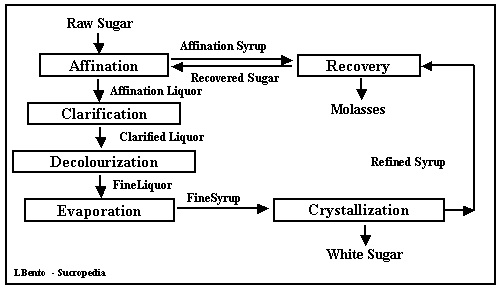
The product obtained in cane sugar mills, raw sugar, does not present qualityb enough chemically and microbiologically) to be used for as food for direct human consumption. Therefore, this product must be further purified to reach the quality demands in order to be considered a direct human food. This purification includes further technological steps globally named as "refining".

Simplified scheme of Cane Sugar Refining
Raw sugar is transported in bulk from sugar mills to refineries where it is stored. From stores, raw sugar is transported through belt conveyors to the Affination section. In this section, raw sugar is mixed with affination syrup at 76 oC, producing affination magma with 92 to 95 oBx. This magma is then centrifuged in
high-speed centrifugals with hot water washing (in some refineries continuous machines are used). During centrifugation sugar crystals are retained in the screen and syrup is separated from the raw sugar. The resulting sugar, affined sugar, is melted with sweet waters producing affination liquor, with a concentration between 65 and 68 oBx. Syrup separated during centrifugation is used to produce the affination magma (in the start up, if no syrup is available, hot water isused ). Excess of affination syrup will be sent to the Recovery section.
With a normal raw sugar (98.5 Polarization and colour around 4,000 IU), affination liquor will have a purity around 99.5 and a colour around 1,500 IU. Due to its high turbidity and due to suspended solids present, affination liquor must be clarified before decolourization. Clarification can be performed using one of three processes: filtration in press filters with filter aids; Carbonatation or Phosphatation.
In the first process, a filter aid is added to the liquor and a filtration is made trough a pre-coat fixed in press filters. This system is very expensive and can be used only when the quantity of suspended solids is minimal. In Carbonatation the filter aid is produced by precipitation of calcium hydroxide with carbon dioxide. During precipitation some impurities and high molecular weight compounds in the liquor are removed by co-precipitation. After carbonatation, liquor is filtered to remove the precipitate formed.
In Phosphatation, phosphoric acid and calcium hydroxide is added to the liquor. The calcium phosphate formed will float on the liquor due to its low density. Floatation is enhanced by bubbling air through the liquor and using flocculants. Cationic polymers can be used in order to improve colourants removal. In clarifiers the precipitate is separated from the clarified liquor and a decolourization of 30 to 50% can be achieved.
Clarified liquor is then decolourized, before evaporation and crystallization. The main decolourizing systems are: ion exchange resins and Adsorbent Carbons, as granular carbons and bone char. Other auxiliary decolourizers can be used, as: powder activated carbons and oxidants as hydrogen peroxide and ozone.
After clarification and decolourization a clear liquor, named fine liquor, with 65 oBx and lower than 250 IU colour is obtained.
In order to save energy and to increase vacuum pan capacity, fine liquor must be concentrated to a higher brix value. This is done by evaporation, normally using a double effect evaporator. Concentrated liquor, named fine syrup, has a concentration around 68 oBx. Fine syrup is then crystallized to extract the maximum possible of sucrose in it.
In Crystallization, fine syrup is processed normally in three boiling scheme. The sugars produced with this boiling scheme are normally mixed producing a white sugar with an average colour around 35 IU.
Massecuite obtainied in crystallization process is centrifuged in high speed centrifugal machines where sugar is separated from mother liquor. After centrifugals, white sugar humidity is around 1.5%. Excess of water is removed in dryers contacting the wet sugar with hot air. Resulting dried sugar is then passed through two screens to remove lumps and fines. To remove bound moisture in sugar crystals, sugar is stored in conditioning silos where sugar is contacted with dry air at 40 oC , during 48 to 72 hours. After conditioning, refined white sugar is classified and prepared to be commercialized in bulk, in one ton containers, 50 kg bags, packets of 1, 2 kg, or other weight, or in small sachets.
The excess of syrups from Affination (affination syrup) or Crystallization (syrup IV) is crystallized in the Recovery section using a three boilings scheme (A, B, C). The result products of Recovery are: recovered sugar, which returns to Affination, and molasses that is discharged from the Refining process.
Bibliography
Cane Sugar Handbook, 1977, Meade - Chen, Chapters 18 and 19, Tenth
Edition,John Wiley & Sons, Inc
Handbook of Sugar Refining, 2000, Ed. C. C. Chou, Pub. John Wiley & Sons
Technology for Sugar Refinery Workers, Oliver Lyle, Chapman & Hall Ltd, Third
Edition, 1957
E0013